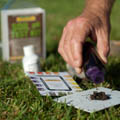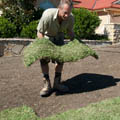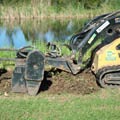 At Sir Walter, we believe that prevention is always better than a cure, so we recommend that you keep Sir Walter healthy. Sir Walter turf has a natural weed resistance that will suffocate the growth of pesky weeds in its normal healthy state.
At Sir Walter, we believe that prevention is always better than a cure, so we recommend that you keep Sir Walter healthy. Sir Walter turf has a natural weed resistance that will suffocate the growth of pesky weeds in its normal healthy state.
Posts tagged as: Soil Preparation Videos
pH Correction Prior to Lawn Installation
 pH – ACID, NEUTRAL AND ALKALINE
pH – ACID, NEUTRAL AND ALKALINE
Your soils’ pH is an important factor, but one that is often overlooked in the eagerness to get your lawn down. pH is measured on a scale from 0 -14 with the lower numbers representing acid soils, the higher numbers alkaline soils and 7 being neutral. READ MORE:
Lawn installation & laying
 Some handy tips from Sir Walter on lawn installation. Let us guide you on laying the perfect Aussie lawn from ground preparation, watering and fertilising to how to lay each piece of Turf, we guide you through the process.
Some handy tips from Sir Walter on lawn installation. Let us guide you on laying the perfect Aussie lawn from ground preparation, watering and fertilising to how to lay each piece of Turf, we guide you through the process.
Excavation
 Sometimes you will need to excavate and remove some soil, often as part of the overall landscape process. For small areas this can be done by hand with shovels, barrows and plenty of sweat; but always remember a cold beer tastes better after a hard days graft.
Sometimes you will need to excavate and remove some soil, often as part of the overall landscape process. For small areas this can be done by hand with shovels, barrows and plenty of sweat; but always remember a cold beer tastes better after a hard days graft.
Preparation for a new lawn (video)
Preparing a New Lawn
The preparation for your new lawn is just as important as the installation and crucial to its success.
Always spray the area with a weed killer such as Glypho 360 to remove any unwanted weeds, vegetation or an existing lawn and remember always follow the instructions.
Digging out existing grasses is not always a good way to kill them as some roots can go down over a metre. If your soil is not ideal and you need to improve the structure, cultivate with Gypsum organic matter for clay soils and plenty of organic matter for sandy soils before spreading a 100mm layer of turf underlay soil mix. For more specific advice do not hesitate to contact us 1300 554 442 – or ask us a question on our Facebook page.
If you have a 150mm of good soil already there is no need to bring in any new soil, just cultivate with a rotary hoe or by hand. In some situations you may want to bring in a layer of turf underlay soil mix, just to help you fine tune those levels before putting the turf down.
Calculating how much soil you will need is fairly easy. For a depth of 100m you will need 1 cubic metre per 10spm and spreading is simple. Once your soil has been cultivated and you have spread your turf underlay soil mix, it’s a great idea to add some Sir Launcher which really helps get your lawn started and established. Mix whatever you have added into the top 75mm, level it out and you are ready to go.
Laying new turf / Lawn Installation (video)
Laying new turf / Lawn Installation
Installing your turf is pretty straight forward. Once you have got your preparation done you are ready to go. Turf is cut fresh at the Turf farm and delivered within 24 hours so lay it as soon as possible to avoid the roots drying out.
If the turf is left stacked for any period of time it will result in heat damage. Now the turf is best laid across any slope, this is particularly important on steep sites.
Start from a straight edge such as a driveway or pavement and lay the turf in a brick work pattern ensuring that the edges fit snugly together. Use a sharp spade, a strong knife or garden sheers to cut the turf and to fit it around irregular shapes in your garden such as trees, garden beds and garden edges.
Once you have got your lawn down it is really important to use a water filled roller, you can hire these on a daily basis. What these do is ensure the roots are in good contact with the soil below. Without this important step the roots can dry out, your turf can dry out and you will end up using a lot more water in the first 24-48 hours.
So whatever you do make sure you roll the turf.
- ARTICLES
- Lawn Care Article: Selecting the right lawn variety
- Lawn Care Article: pH Correction to lawn installation
- Lawn Care Article: Excavation
- Lawn Care Article: Lawn Installation and Laying
- VIDEOS
- Lawn Care Video: Launch your lawn / lawn installation
- Lawn Care Video: Preparation for your new lawn
- Lawn Care Video: Measuring your lawn area / Lawn Installation
Lime & Gypsum (video)
Lime and Gypsum
Gypsum, also known as calcium sulphate helps to break down and open up a clay soil allowing water, nutrients, air and lawn roots to penetrate into the soil more easily which is exactly what you want.
Now if you’ve got a clay soil it’s best to incorporate the gypsum into the soil before you spread your turf underlay mix. You can do this with a rotary hoe or you could just use a mattock for small areas.
For an existing lawn use a garden fork, push it in while moving it back and forth. Broadcast the required amount of lime over the area and water it into the soil. Now sometimes you lawn will get damaged from general wear and tear from pets or high traffic and even cold weather. Gypsum will help repair these areas.
Now always read the instructions on the bag buy as a general rule for light clay soils you need to apply 1 kg per square metre and for heavy clay soils you double it to 2 kg per square metre. And remember this too, gypsum is pH neutral, if you want to raise your soils pH you need to apply lime or dolomite.
The Importance of Soil pH for Your Lawn (video)
The Importance of Soil pH for Your Lawn
Sometimes you may find your lawn is not performing very well or not responding to fertiliser and this could be to do with the soils pH.
Now pH is a measure of acidity and alkalinity and Sir Walter lawns like to be in the 6 to 7.5 range for optimum performance. A pH in the right range of 6 to 7.5 is a bit like a plant with its mouth wide open, no food will go to waste here and it will all be eaten by the plant.
Adjusting the pH is easier on loamy and sandy soils than on heavy clays. If your soil is a sandy loam and you need to raise the soil pH by one unit add the equivalent of 150g of liming material per square metre. An adult handful is about 100g.
Heavy clay soils will require at least 250g to raise the pH by one unit. A super fine grade of lime works quickest and generally costs around $8 a bag.
For an established lawn, which may be lacking magnesium, mix 50/50 lime and dolomite as the liming material to get the right balance of calcium and magnesium. Dolomite is only available in one grade and costs around $8 a bag.
After applying lime or dolomite make sure you water them well so that it moves into the soil. Testing the soil’s pH may seem like some mad scientific operation but it couldn’t be simpler with one of the soil pH test kits. All you have to do is follow the instructions and it even tells you how to make the changes.
You can get all the lawn care products you will need here at our online Lawnstore.








